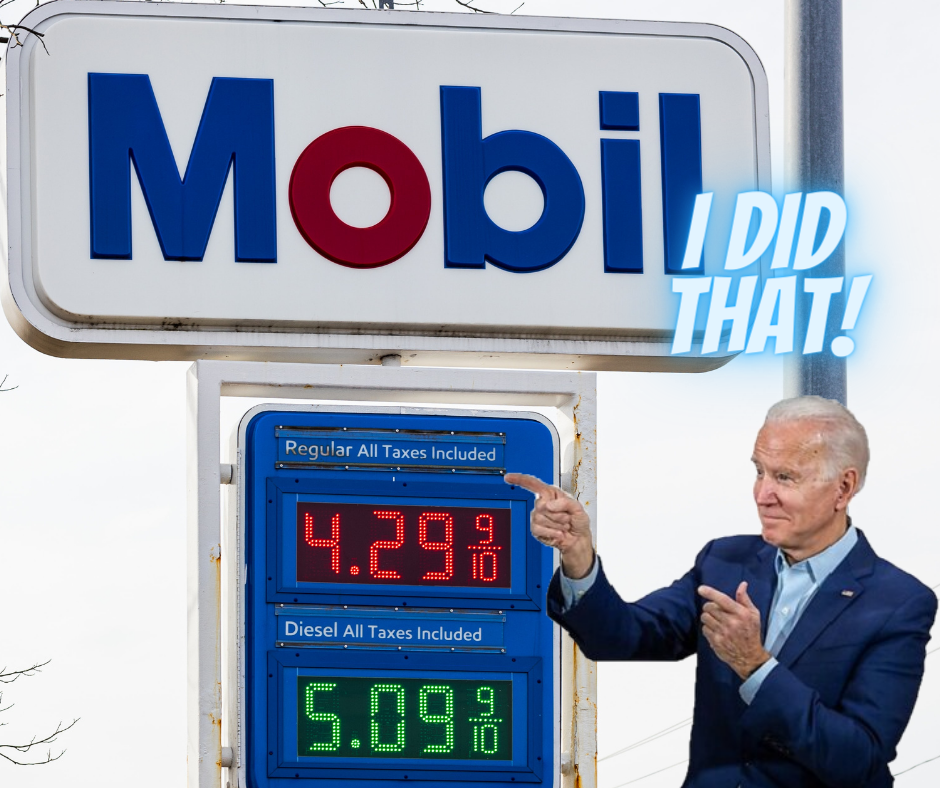Yup, It’s true, energy companies have been profitable lately…to the tune of an 8.3% profit in 2021. The only segment worse than energy was consumer staples with a profit margin of 6.6%. Yet here we are talking about windfall profits. In this episode we break down this proposal and how it will have the opposite effect on energy prices than what is intended.
Be sure to also subscribe on Apple Podcasts via the link above and please leave us an honest rating and review. We read every one of them and sincerely appreciate any feedback you have. To ask us a question to be featured on an upcoming episode, please leave a comment below or send an email to feedback@mineralrightspodcast.com.
High Prices at the Pump Worry Politicians
As we reported in MRP 138: How High Oil Prices and Inflation Will Affect Royalty Owners on January 26th of 2022 when oil was trading at around $88/bbl (before Russia invaded Ukraine):
“My hope is that oil stays below $90 because if it goes higher than that or certainly higher than $100 per barrel, we are likely going to see customers reacting by cutting back, call it a demand shock but basically if oil reaches a level where companies are losing money by continuing to buy at those levels they will just shut down manufacturing or whatever their business is until prices drop back down. More worrisome would be the political response that $100+ oil prices would likely solicit. You start to get into windfall profits conversations and other nonsensical arguments against producers. Too high oil prices are not good for anyone.
The US Government has traditionally shown a high level of incompetence when it comes to understanding supply & demand so they would likely foolishly call on OPEC to increase production instead of spurring additional investment in growing production domestically. Ironically, OPEC is already at their limit and can’t really produce any more oil then they currently are, with the possible exception of Saudi Arabia which may have some surplus capacity. But again, our political climate and the heavy push to invest heavily in green projects while simultaneously cutting off funding for oil and gas companies is starting to rear its ugly head in terms of oil prices.”
Episode 138
Since then oil reached a peak of over $123/bbl and has since come back down below $100 briefly and is trading today near $104/bbl. The biggest impact that we have seen here in the US from higher oil prices has been at the pump. The national average gasoline prices peaked at around $4.33 last week and are now hovering around $4.27/gal. This is up from a year ago when the average gas price was $2.88/gal. For comparison, a year ago the price of crude oil was $63.22 for the week of March 15th 2021. So gas prices are up around 48% from this time last year while the price of crude oil is up by around 64% over the same time period.
The Relationship Between Crude Oil and Gasoline Prices
Higher gas prices have been the focus lately but the question should be to ask how gasoline prices work, not just blaming oil companies for higher gas prices. It is like blaming the cow when the price of milk goes up. I thought that Brian Sullivan on CNBC did a good job of explaining how oil prices affect prices at the pump in this clip:
I think this is an interesting clip and one of the biggest takeaways for me is the fact that it can take a week or two for gasoline inventories to turn over at most gas stations. That means that gas station owners are stuck with a higher cost product and they need to recoup costs sometimes after gasoline prices have fallen.
Plus, in 2020, when oil went negative did gas prices go negative too? Of course not!
How the Crude Oil Market Works
As we discuss in detail in MRP 52: How Crude Oil Prices Work, Oil is a global commodity whose price is primarily determined by supply and demand. When demand exceeds the available supply, prices rise. When supply matches or exceeds the demand for oil, then the price falls. So there are two ways to lower oil prices. Either decrease demand or increase supply (or a combination of both).
Politicians are focusing on the demand side of the equation which in their mind involves buying an EV. There have been a lot of political meme’s about Stephen Colbert’s recent bit saying that he’s willing to pay more to have a good conscience about the environment and that is why he drives a Tesla but the fact of the matter is this is not the solution for most people. Buying a $60,000 Electric Vehicle (EV) is out of reach for many Americans who can barely afford to fix the water pump in their car.
News Flash: The Energy Transition Will Take Decades
In the long run, part of the solution is to become more efficient to help reduce demand for oil for transportation fuels. That said, we are decades away from that being a reality. So, the solution is not to tell people to just go buy an EV so you won’t have to worry about prices at the pump, we need to take more immediate action. We can’t have a material impact on demand in the next 6 to 12 months but we can have a material impact on supply.
And while you may be surprised to hear me say, I agree with the President that high oil prices are not necessarily due to environmental measures. It is due to more demand for crude oil than available supply. And while politicians often get unfairly blamed for macroeconomic issues, in this case we are starting to see the effects of underinvestment in growing supply. And while some of this is self-inflicted by the industry due to mismanagement of capital over the past several years, some of the anti-fossil fuel policies over the past year and a half are starting to have an effect as well.
What is the Big Oil Windfall Profits Tax?
In response to these higher gas prices, a bill has been introduced to impose “a windfall profits excise tax on crude oil and to rebate the tax collected back to individual taxpayers, and for other purposes.”
This is completely misguided legislation and appears to be another tactic in making it harder and more costly for American oil and gas producers to grow production. Other steps the Biden Administration has taken towards this include canceling the Keystone XL pipeline, implementing policies like bans on leasing and issuing new drilling permits on federal lands.
Rather than continuing to demonize the oil and gas industry, why not work together to incentivize these companies to reinvest money in drilling new wells at a moderate pace while still living within cash flow.
A Windfall Profits Tax Won’t Help Lower Gas Prices
This is what the American Petroleum Institute had to say about windfall profits tax:
“The American people are looking for solutions, not finger pointing. The price at the pump that Americans are currently paying is a function of increased demand and lagging supply combined with the geopolitical turmoil resulting from Russia’s aggression in Ukraine. Lawmakers should focus on policies that increase US supply to help mitigate the situation rather than political grandstanding that does nothing but discourage investment at a time when it’s needed the most.”
API Statement on Windfall Profit Tax Legislation
And there was an excellent opinion piece in the Wall Street Journal recently about these issues stating:
“You knew it was coming. Even as President Biden begs OPEC to pump more oil, Senate Democrats are threatening to punish U.S. oil companies with a windfall-profits tax if they increase production. The contradiction nicely summarizes progressive energy policy.”
The Unintended Consequences of a Windfall Profits Tax:
- The plan that has been proposed requires companies that produce or import more than 300,000 bbls per day to pay a per barrel tax equal to 50% of the difference between the current and average price between 2015 and 2019 which is around $57/bbl. Smaller companies would be exempt.
- The issue with this is Oil companies don’t set prices. The Federal Trade Commission has proven this.
- Progressives have been pushing for more investment in green energy while pushing investors away from investing in oil companies.
- The windfall profits tax proposal shows that democrats don’t want American companies to increase oil production so that gasoline prices would fall. I say this because a windfall profits tax would provide a disincentive for additional investment in US oil projects. The fact of the matter is these larger companies that would be affected by this are going to be incentivized to invest their money elsewhere where the economics are not burdened by an additional 50% excise tax on crude oil sales. At current prices of around $104/bbl this proposal would make around $47/bbl subject to this additional 50% tax which would equate to around $23.5/bbl.
- This is effectively a 22.5% penalty on any additional barrels produced here in the United States. So it makes the economics of projects in other countries look quite good in comparison. Fact of the matter is few international projects can bring on additional production as quickly as US shale. Many of these projects are multi-billion dollar deep water projects that will take decades to bring online.
- The impact of a windfall profits tax will have the exact opposite effect on crude oil price and as a result, gasoline prices. It will decrease additional supply while not doing much to decrease demand. I think it will actually cause prices to go higher.
- It would be bad for our kids, while it would be nice to get a check from the government, realize that money has to come from somewhere. There are no free lunches. Getting a check now will just cost us more a few years from now due to lack of investment in critical energy projects to help supply the world with the energy it needs.
What Are Oil Company Profit Margins?
So the question on everyone’s mind is exactly what are the profit margins of oil and gas companies, are they exceptionally high?
The short answer is no. In fact, in 2015 Oil and Gas Extraction was the 3rd most profitable industry with profit margins of 16.4%. In 2021, profit margins for energy firms listed in the S&P 500 stock index reported a profit margin of only 8.3%. The only sector that did worse last year was consumer staples at a meager 6.6% profit margin. Not surprisingly, the top sectors in 2021 were Financials at 25.3%, Tech at 23.2%, and pharmaceuticals at 23.1%.
Such is the case with commodity industries like oil and gas extraction. Losses and low profit margins like when oil prices went negative in 2020 offset higher profits when oil prices are high. The times of higher profit helps sustain these companies through tough times and prevents them from having to layoff employees.
In closing, I can see the benefit of working with oil and gas companies to reduce stock buybacks so they can reinvest in drilling new wells given the current situation. Punishing them with a windfall profits tax will instead have the exact opposite effect of growing production. Instead, companies will go where they aren’t faced with punitive excise taxes and the taxpayers will be the ones that are hurt the most.
Resources Mentioned in This Episode
- ‘Big Oil Windfall Profits Tax Act’ Full Text
- ‘Big Oil’ & The Fallacy Of A Windfall Profits Tax | ZeroHedge
- Democrats blame oil companies for high fuel prices. But the facts don’t back them up.
- ‘I Want To Address One Myth’: Biden Says High Gas Prices Not Linked To Climate Change Agenda
- Big Oil isn’t as rich as everybody thinks
Thanks for Listening!
To share your thoughts:
- Leave a comment or question below (we read each one and your question may be featured in a future episode)!
- Ask a question or leave us feedback via email.
To help out the show:
Click the Apple Podcasts Logo Above to leave us a rating & review. It really helps us reach those that need to hear this information and only takes a minute. We greatly appreciate it! Plus, you can get a shout out on a future episode!
Thanks again – until next time!



